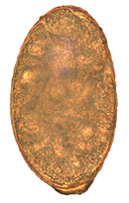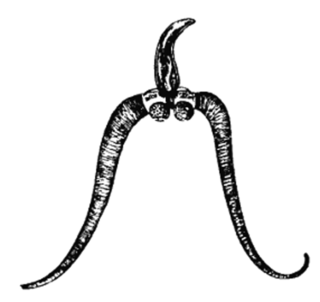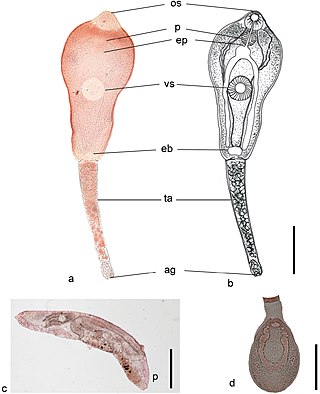
Trematoda is a class of flatworms known as flukes or trematodes. They are obligate internal parasites with a complex life cycle requiring at least two hosts. The intermediate host, in which asexual reproduction occurs, is usually a snail. The definitive host, where the flukes sexually reproduce, is a vertebrate. Infection by trematodes can cause disease in all five traditional vertebrate classes: mammals, birds, amphibians, reptiles, and fish.
Metagonimiasis is a disease caused by an intestinal trematode, most commonly Metagonimus yokagawai, but sometimes by M. takashii or M. miyatai. The metagonimiasis-causing flukes are one of two minute flukes called the heterophyids. Metagonimiasis was described by Katsurasa in 1911–1913 when he first observed eggs of M. yokagawai in feces. M. takahashii was described later first by Suzuki in 1930 and then M. miyatai was described in 1984 by Saito.
Microphallus piriformes is a parasitic trematode (fluke). It belongs to the Xiphidiata, a large suborder of the digenean fluke order Plagiorchiida. M. piriformes is unusual among the flukes in having only one intermediate host rather than two, and no free-swimming cercarian stage.
Microphallus is a genus of parasitic trematodes (flukes) in the family Microphallidae. The Greek name means "tiny penis".

Trematodes are parasitic flatworms of the class Trematoda, specifically parasitic flukes with two suckers: one ventral and the other oral. Trematodes are covered by a tegument, that protects the organism from the environment by providing secretory and absorptive functions.
Ribeiroia is a genus of trematode parasites that sequentially infect freshwater snails in the family Planorbidae as first intermediate hosts, fish and larval amphibians as second intermediate hosts, and birds and mammals as definitive hosts. In North America, infection by Ribeiroia has been linked to amphibians with limb malformations. The connection between parasitic infection and limb malformations has generated questions about (a) whether parasite-induced malformations in amphibians are increasing, and (b) the consequences of such abnormalities for amphibian population conservation.

The common periwinkle or winkle is a species of small edible whelk or sea snail, a marine gastropod mollusc that has gills and an operculum, and is classified within the family Littorinidae, the periwinkles.

Paragonimiasis is a food-borne parasitic disease caused by several species of lung flukes belonging to genus Paragonimus. Infection is acquired by eating crustaceans such as crabs and crayfishes which host the infective forms called metacercariae, or by eating raw or undercooked meat of mammals harboring the metacercariae from crustaceans.
A molluscivore is a carnivorous animal that specialises in feeding on molluscs such as gastropods, bivalves, brachiopods and cephalopods. Known molluscivores include numerous predatory molluscs,, arthropods such as crabs and firefly larvae, and, vertebrates such as fish, birds and mammals. Molluscivory is performed in a variety ways with some animals highly adapted to this method of feeding behaviour. A similar behaviour, durophagy, describes the feeding of animals that consume hard-shelled or exoskeleton bearing organisms, such as corals, shelled molluscs, or crabs.

Leucochloridium variae, the brown-banded broodsac, is a species of trematode whose life cycle involves the alternate parasitic infection of certain species of snail and bird. While there is no external evidence of the worm's existence within the bird host, the infection of the snail host is visible when its eye stalks become grotesquely engorged with the parasite's brood sacs. These brood sacks pulsate and move to imitate insect larva, attracting the parasite's next host, insectivore birds. The bird rips off the eye stalk and eats it, thus becoming infected. Later on, the parasite's eggs are dropped with the bird's feces. Similar life-histories are found in other species of the genus Leucochloridium, including Leucochloridium paradoxum.
Ribeiroia ondatrae, or the frog-mutating flatworm is a parasite in the genus Ribeiroia which is believed to be responsible for many of the recent increases in amphibian limb malformations, particularly missing, malformed, and additional hind legs.

Nanophyetus salmincola is a food-borne intestinal trematode parasite prevalent on the Pacific Northwest coast. The species may be the most common trematode endemic to the United States.

Bucephalus polymorphus is a type of flatworm. This species is within the Bucephalidae family of Digenea, which in turn is a subclass of Trematodes within the phylum Platyhelminthes. It is characterized by having a mouth near the middle of its body, along with a sac-like gut. The mouth opening is located in the centre of the ventral surface. This is a specific body type of cecaria known as a gastrostome.

Parasitic castration is the strategy, by a parasite, of blocking reproduction by its host, completely or in part, to its own benefit. This is one of six major strategies within parasitism.

Heterophyes heterophyes, or the intestinal fish fluke, was discovered by Theodor Maximaillian Bilharz in 1851. This parasite was found during an autopsy of an Egyptian mummy. H. heterophyes is found in the Middle East, West Europe and Africa. They use different species to complete their complex lifestyle. Humans and other mammals are the definitive host, first intermediate host are snails, and second intermediate are fish. Mammals that come in contact with the parasite are dogs, humans, and cats. Snails that are affected by this parasite are the Cerithideopsilla conica. Fish that come in contact with this parasite are Mugil cephalus, Tilapia milotica, Aphanius fasciatus, and Acanthgobius sp. Humans and mammals will come in contact with this parasite by the consumption of contaminated or raw fish. This parasite is one of the smallest endoparasite to infect humans. It can cause intestinal infection called heterophyiasis.
Echinostoma hortense is an intestinal fluke of the class Trematoda, which has been found to infect humans in East Asian countries such as Korea, China, and Japan. This parasite resides in the intestines of birds, rats and other mammals such as humans. While human infections are very rare in other regions of the world, East Asian countries have reported human infections up to about 24% of the population in some endemic sub-regions. E. hortense infections are zoonotic infections, which occurs from eating raw or undercooked freshwater fish. The primary disease associated with an E. hortense infection is called echinostomiasis, which is a general name given to diseases caused by Trematodes of the genus Echinostoma.

Cerithideopsis californica, common name the California hornsnail or the California horn snail, is a species of sea snail, a marine gastropod mollusk in the family Potamididae. This series was previously known as Cerithidea californica.

Clinostomum marginatum is a species of parasitic fluke. It is commonly called the "yellow grub". It is found in many freshwater fish in North America, and no fish so far is immune to this parasite. It is also found in frogs. Clinostomum marginatum can also be found in the mouth of aquatic birds such as herons and egrets. They are commonly present in the esophagus of fish-eating birds and reptiles. Eggs of these trematodes are shed in the feces of aquatic birds and released into water. Aquatic birds become hosts of this parasite by ingesting infected freshwater fish. The metacercariae are found right beneath the skin or in the muscles of host fish.

Philophthalmus gralli, commonly known as the Oriental avian eye fluke, parasitises the conjunctival sac of the eyes of many species of birds, including birds of the orders Galliformes and Anseriformes. In Brazil this parasite was reported in native Anseriformes species. It was first discovered by Mathis and Leger in 1910 in domestic chickens from Hanoi, Vietnam. Birds are definitive hosts and freshwater snail species are intermediate hosts. Human cases of philophthalmosis are rare, but have been previously reported in Europe, Asia, and America.
Behavior-altering parasites are parasites with two or more hosts, capable of causing changes in the behavior of one of their hosts to enhance their transmission, sometimes directly affecting the hosts' decision-making and behavior control mechanisms. They do this by making the intermediate host, where they may reproduce asexually, more likely to be eaten by a predator at a higher trophic level which becomes the definitive host where the parasite reproduces sexually; the mechanism is therefore sometimes called parasite increased trophic facilitation or parasite increased trophic transmission. Examples can be found in bacteria, protozoa, viruses, and animals. Parasites may also alter the host behaviour to increase protection of the parasites or their offspring; the term bodyguard manipulation is used for such mechanisms.











